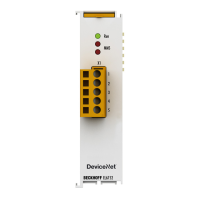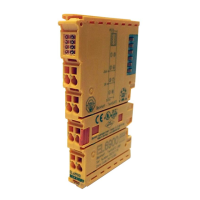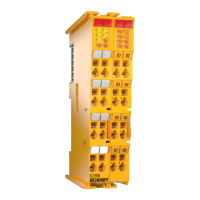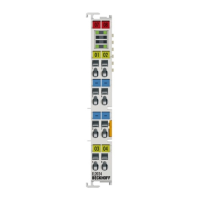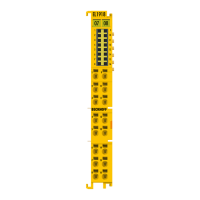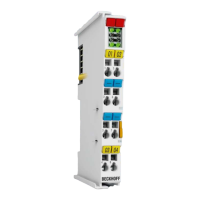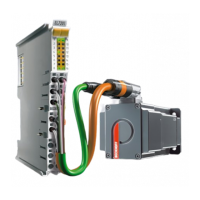Parameterization and commissioning
EL6731120 Version: 2.8
Diagnostic data
Any DP slave can acyclically report DP diagnostic data during data exchange operation. The slave here sets
the Diag_Flag in the response to the cyclic Data_Exchange telegram, as a result of which the DP master
automatically reads the DP diagnostic data from the slave. This does not affect the Data-Exchange cycle in
the Beckhoff DP master, because the DP diagnostic telegram is sent at the end of the cyclic Data-Exchange
cycle, and before the beginning of the next cycle. If the DP diagnostic data read from the slave has changed
from its previous state, the DP master sets the "ExtDiagFlag" variable, which can be linked to a variable in
the controller program.
The DP slave's current diagnostic data is displayed in the system manager on the slave’s Diag [}100] tab. It
can also be read by the controller program via ADS [}42], which will cause the "ExtDiagFlag" flag to be reset
once more:
ADS-Read parameters Meaning
Net-ID
Net-ID of the master (see the device's ADS [}92] tab)
Port 200
IndexGroup 0x00yyF181 (yy = station address of the slave)
IndexOffset offset within the diagnosis data
Length Length of the diagnostic data that is to be read
Data Diagnostic data
The diagnostic data contains the slave statistics (32 bytes) and the DP diagnostic data sent by the slave (up
to 244 bytes), and is constructed as follows:
Offset Meaning
Slave statistics
0 Receive Error Counter (WORD): The number of faulty telegrams occurring while
communicating with this slave.
2 Repeat Counter[8] (WORD): The repeat counters indicate how many repeats have
had to be made, and how often. Repeat Counter[0] indicates how often it has been
necessary to repeat a telegram for this slave once, Repeat Counter[1] shows how
often a telegram for this slave has had to be repeated twice, and so on. The
maximum number of retries is set with the parameter Max Retry Limit (see Bus
parameters [}87] dialog). The value range is from 0 to 8, therefore there are 8
repeat counters (for 1 to 8 retries)
18 reserved for extensions
20 NoAnswer Counter (DWORD): The number of telegrams in communication with
this slave that have not received an answer. The first time that a slave fails to
answer, the telegram is repeated up to MaxRetryLimit times, but if it does not
answer even then, further telegrams are not repeated.
24-27 Last-DPV1-Error[4] (BYTE): The most recent faulty DPV1 response is entered here
(byte 0: DPV1 service (bit 7 is set, thus indicating an error), byte 1: Error_Decode,
byte 2: Error_Code_1 (Error_Class/Error_Code), byte 3: Error_Code_2), see
description of the DPV1 error codes [}126]
27-31 reserved for extensions
from 32
DP diagnostic data [}123]
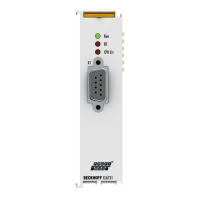
